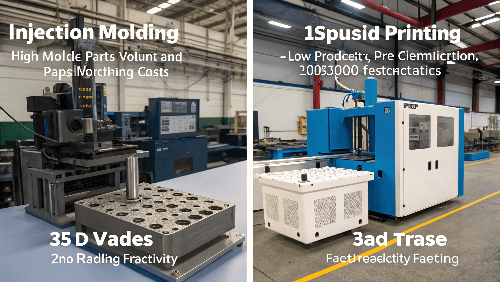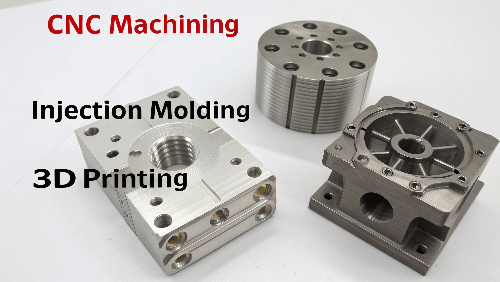Choosing the wrong manufacturing method wastes time and money. Project delays and budget overruns often stem from picking a process unsuitable for your needs.
The best process depends on volume, complexity, material, cost, and speed. 3D printing suits prototypes/low volume, CNC for precision/strength, and injection molding excels at high-volume production.
I often talk with designers like Jacky, who need parts ranging from initial prototypes to large-scale production runs. Picking the right path – Additive Manufacturing (3D Printing)1, Subtractive Manufacturing (CNC Machining)2, or Forming (Injection Molding)3 – is crucial right from the start. Let’s dive into how these methods differ and where each one shines.
What is the difference between 3D printing, CNC machining, and injection moulding?
Confused about whether to print, mill, or mold your parts? Using the wrong technique leads to unexpected costs, delays, or parts that don’t meet requirements.
3D printing adds material layer by layer. CNC machining removes material from a block. Injection molding injects molten material into a mold cavity to form parts.
!
Understanding the fundamental difference is the first step. Each method builds or shapes parts in a unique way, dictating its strengths and weaknesses.
Core Process Differences
- 3D Printing (Additive Manufacturing): Builds objects layer by layer from a digital file. Think of it like constructing something from the ground up with materials like plastic filaments, resins, or powders. It’s great for complex geometries.
- CNC Machining (Subtractive Manufacturing): Starts with a solid block of material (metal, plastic, wood) and uses computer-controlled cutting tools (drills, mills) to remove material until the desired shape is achieved. Precision is a key advantage.
- Injection Molding (Forming/Molding): Involves creating a custom mold (usually metal). Molten plastic is then injected under high pressure into the mold cavity. Once cooled, the solid part is ejected. This process is designed for repeatability at scale.
Quick Comparison Table
Feature 3D Printing CNC Machining Injection Molding Process Type Additive Subtractive Forming/Molding Typical Use Prototypes, Custom Parts, Complex Prototypes, Low-Mid Volume, High Strength/Precision High Volume Production Materials Plastics, Resins, Some Metals Metals, Plastics, Wood, Foam Thermoplastics, Some Thermosets Complexity High (complex internal features) Moderate (access limitations) Lower (moldability constraints) Lead Time Short (hours/days for first part) Moderate (days/weeks) Long (weeks/months for tooling) Cost Low setup, High per part Moderate setup, Moderate per part High setup, Very Low per part Accuracy Moderate to High Very High High (with good tooling) Is CNC machining better than 3D printing?
Struggling to decide between CNC and 3D printing for your part? Choosing incorrectly might mean parts lack strength, precision, or take too long to produce.
Neither is universally "better." CNC excels in strength, tolerance, and material options similar to end-use parts. 3D printing is faster for complex prototypes and requires no tooling.

The "better" choice really depends on what you need the part for. I’ve used both extensively, and they serve different purposes very well.When CNC Wins
- Material Properties & Strength: CNC can work with solid blocks of production-grade metals (aluminum, steel) and plastics (ABS, Nylon, PEEK). The resulting parts retain the inherent strength and characteristics of the bulk material, making them ideal for functional testing or end-use parts. 3D printed parts, especially FDM, can have anisotropic properties (weaker between layers).
- Accuracy & Tolerances: CNC machining is generally capable of achieving much tighter tolerances4 and smoother surface finishes than most 3D printing methods. If your part requires high precision for fit or function, CNC is often the preferred route.
- No Porosity: Machined parts are fully dense5, unlike some 3D printing processes which might leave microscopic voids.
When 3D Printing Wins
- Speed for Prototypes: Getting a first physical part can be much faster with 3D printing (hours or days) as there’s no fixture setup or extensive programming needed. This accelerates design iteration.
- Geometric Complexity: 3D printing can create highly complex internal features, organic shapes, and intricate geometries that would be difficult or impossible to machine with CNC due to tool access limitations.
- Lower Initial Cost: For one-off parts or very small quantities, 3D printing avoids the setup time and potential fixturing costs associated with CNC.
- Material Efficiency: As an additive process, it generally uses only the material needed for the part, potentially creating less waste than subtractive CNC, although support structures are sometimes needed.
Is injection molding better than 3D printing?
Deciding between injection molding and 3D printing for your plastic parts? One offers low per-part costs at scale, the other speed and flexibility for low volumes. Misunderstanding this trade-off can be costly.
Injection molding is "better" for high-volume production due to extremely low per-part costs. 3D printing is "better" for prototypes, customization, and low volumes due to speed and no tooling investment.

This comparison often comes down to quantity. If you need thousands or millions of identical plastic parts, injection molding is almost always the answer. For just a few, 3D printing reigns supreme.When Injection Molding Wins
- Cost at Scale: The main advantage. While initial mold costs are high ($ thousands to $$ hundreds of thousands), the cost per part becomes pennies once you produce large quantities (thousands to millions). Material costs are relatively low, and cycle times are fast (seconds).
- Material Selection: Offers the widest range of production-grade thermoplastic materials with well-defined properties. Color matching and specific additives are easily managed.
- Surface Finish & Repeatability: Can produce excellent surface finishes directly from the mold. Once dialed in, the process is highly repeatable, ensuring consistency across huge production runs.
- Strength: Molded parts are typically strong and isotropic (uniform strength in all directions).
When 3D Printing Wins
- Speed for Initial Parts: Perfect for rapid prototyping. You can have a physical part in hand quickly to test form and fit without waiting weeks or months for a mold.
- No Tooling Cost: The biggest barrier to injection molding (high mold cost) is completely absent. This makes 3D printing ideal for one-offs, custom parts, or very low volume runs.
- Design Flexibility: Allows for easy design changes between iterations. Modifying an injection mold is expensive and time-consuming; modifying a 3D model is simple. Handles complex geometries well.
- Bridge Production: Can be used to produce initial batches of parts while the injection mold is being made (bridge tooling or direct production).
Which machining process is more accurate?
Need parts with extremely tight tolerances for a critical application? Choosing a process that can’t meet your accuracy requirements will result in failed assemblies or poor performance.
Generally, CNC machining offers the highest accuracy and tightest tolerances. Injection molding can be very accurate with high-quality tooling and process control. 3D printing accuracy varies significantly by technology.

Accuracy is often a critical factor, especially for parts that need to interface with others. Here’s how these processes stack up:Accuracy Breakdown
- CNC Machining: This typically provides the highest level of accuracy and the tightest achievable tolerances, often down to +/- 0.001 inches (0.025 mm) or even better, depending on the machine, setup, material, and operator skill. The subtractive process allows for precise dimensional control and excellent surface finishes. It’s the benchmark for precision.
- Injection Molding: Capable of high accuracy and repeatability, especially for large volumes. Tolerances depend heavily on the quality of the mold (precisely machined cavities), the consistency of the molding process (temperature, pressure, time control), and the behavior of the chosen plastic (shrinkage rate). Typical tolerances might be around +/- 0.005 inches (0.127 mm), but tighter is possible with careful design and process control. Consistency across parts is a major strength once the process is stable.
- 3D Printing: Accuracy varies widely depending on the specific technology and calibration.
- SLA/DLP (Resin-based): Often provide higher accuracy and finer details, suitable for intricate parts.
- FDM (Filament-based): Generally less accurate, especially on larger parts, with visible layer lines. Tolerances might be +/- 0.010 inches (0.254 mm) or wider.
- SLS/MJF (Powder-based): Offer a good balance of accuracy and strength.
Factors like layer height, shrinkage, warping, and support structure removal all influence the final accuracy of 3D printed parts.Conclusion
Choosing between 3D printing, CNC machining, and injection molding hinges on your specific needs: prioritize 3D printing for speed/prototypes, CNC for precision/strength, and injection molding for cost-effective high-volume production.
-
Explore the benefits of Additive Manufacturing to understand how it can enhance your prototyping and production processes. ↩
-
Learn about CNC Machining to see how it can provide precision and strength for your manufacturing needs. ↩
-
Discover the efficiency of Injection Molding for high-volume production and how it can save costs. ↩
-
Learn how tighter tolerances in CNC machining enhance the quality and functionality of parts, making it crucial for precision engineering. ↩
-
Discover the significance of fully dense parts in CNC machining and how it impacts the strength and reliability of manufactured components. ↩
